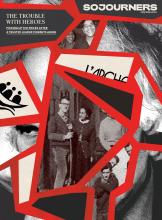IT WOULD HAVE been tough to be both a disciple of Jesus and a foodie. Don’t get me wrong, Jesus certainly valued food — his earthly ministry was filled with meals: The gospel of Matthew describes Jesus as one who “came eating and drinking” (11:19). As Robert J. Karris wrote in Eating Your Way Through Luke’s Gospel, Jesus was “either going to a meal, at a meal, or coming from a meal.” But what the Chosen One had in meal frequency, he lacked in meal diversity.
A “foodie” is someone who eats food as a hobby — a passion, even. The more exotic the better. If you pull up to your local boba shop, why settle for regular milk tea when you can order one infused with butterfly pea flower that turns it bright blue?
However, for Jesus’ meals, at least the ones recorded in scripture, the fish is served broiled (Luke 24:42), not creatively deconstructed. And if you’re rolling with Jesus, you better like eating bread.
Though his plate may have lacked the splendor of the centurions’ or high priests’ spreads, Jesus viewed the table as a radical place of inclusion. For many powerful religious leaders of the time, dining was yet another way to shun the outcasts. In contrast, Jesus intentionally invited those very same “unclean” people to dine with him, breaking bread (because of course it was bread) with tax collectors, sinners, and prostitutes.
In the past year, several films have articulated a hunger for the type of table Jesus championed. Flux Gourmet, Triangle of Sadness, and The Menu critique class inequality through stories revolving around fine dining. In each movie, wealthy people have rich flavors but a dearth of meaningful relationships. The exclusivity of the table seems more important than the actual food served on the plates. Jesus’ table, on the other hand, lacked variety but overflowed in inclusivity — a true palate cleanser to meals that symbolized selfish consumption.
Read the Full Article

